The 87-acre field of weeds and rubble with a view of Treasure Island, downtown San Francisco, the Berkeley shoreline and the Bay Bridge was once Stauffer Chemical. Climate models show this acreage nearly surrounded by water in just a few decades.
The company dumped iron pyrite cylinders into the marsh near the site and made pesticides, herbicides and fertilizers.
Zeneca Corp., now called AstraZeneca, purchased the site in the 1980s. The company manufactured sulfuric acid and pesticides and closed the site in 1997; shortly after, the federal government deemed it a Superfund site. The developer, HRP Campus Bay Property LLC, did not return KQED emails for comment.
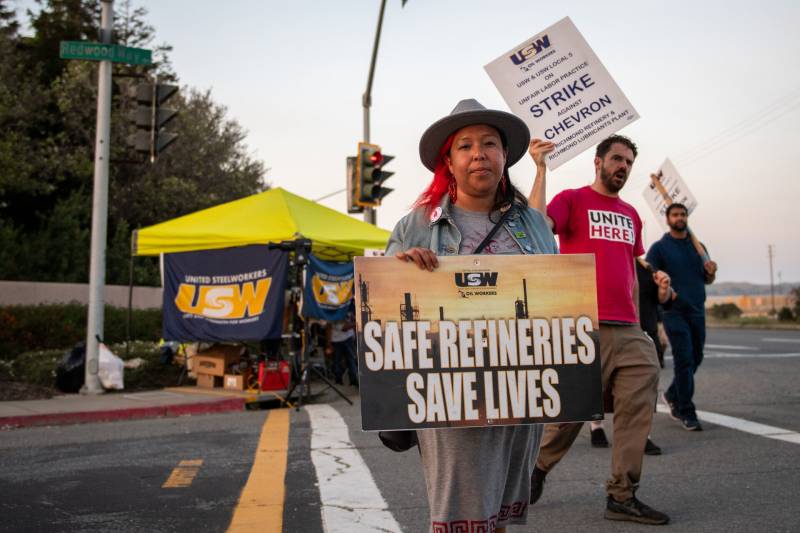 Marisol Cantú walks with Chevron refinery employees and their supporters in front of Gate 14 at the Richmond refinery on April 7, 2022, to protest for worker safety and higher pay. (Beth LaBerge/KQED)
Marisol Cantú walks with Chevron refinery employees and their supporters in front of Gate 14 at the Richmond refinery on April 7, 2022, to protest for worker safety and higher pay. (Beth LaBerge/KQED)
Community resistance
Local climate activists, like 34-year-old Marisol Cantú with the Richmond Progressive Alliance, said that a developer building homes on a toxic site will only further environmental injustice and compromise the health of residents in this city of nearly 90% people of color.
“People are unaware because I think they are simply trying to survive,” said Cantú of buried contaminants like lead and benzene. She organizes a youth-led climate justice podcast, Richmond Listening Project.
“When you tell them there’s a contaminated site, and the [city] wants to build residential housing on it, they’re flabbergasted,” she said.
If construction begins on the housing development and there’s still contamination in the soil, Cantú said advocates will protest.
“I could see community members and environmental justice advocates, laying themselves down human-chain-style to make sure that no bulldozers pass,” she said.
Two decades of community pushback against the development project have made the AstraZeneca site one of the highest-profile sites in the region. Hundreds, if not thousands, of polluted areas litter the shoreline. Developers are pursuing plans to build homes or businesses above many of these, like the Hunters Point Naval Shipyard in San Francisco.
At the same time, cities are under pressure to build more homes because of the region’s critical need for affordable housing. The struggle at the Richmond site is an example of the growing challenge of developing the shoreline where the Bay Area’s industrial past intersects with its climate future.
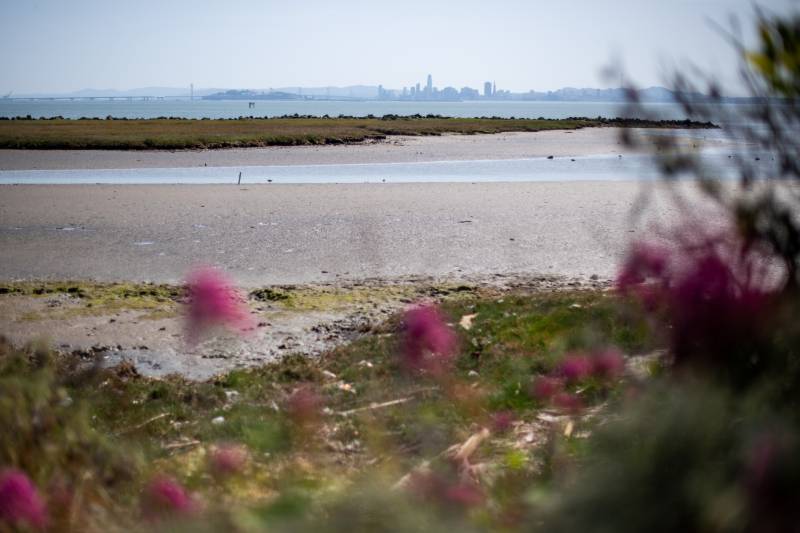 The San Francisco skyline can be seen at the South Richmond Marshes on April 7, 2022. (Beth LeBerge/KQED)
The San Francisco skyline can be seen at the South Richmond Marshes on April 7, 2022. (Beth LeBerge/KQED)
‘My community is not prepared’
In the late 1990s, Eric Blum built a tan two-story cinder block photography studio a block away from what looked like an abandoned field. It was the perfect spot for his product and nature photography studio — an industrial zone off Interstate 580.
Blum’s adult children explored the marsh south of AstraZeneca when they were young.
At first, his family was in awe of the colors in the water, soil and a short cliff rising out of the marsh — a mix of purple, apricot and amber hues that almost mirrored the color of the sunset over the water.
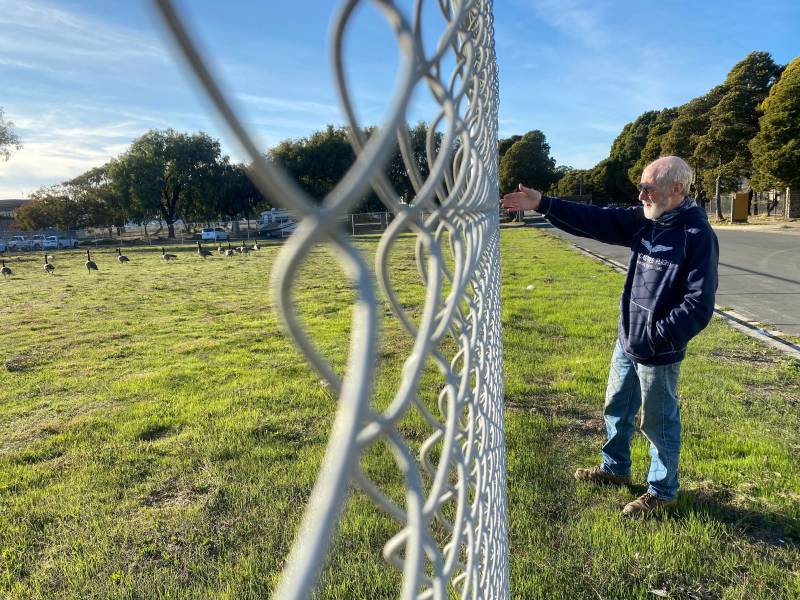 Eric Blum owns a photography studio one block away from the AstraZeneca site. He says a plume of gases has moved off-site to the edge of his property. (Ezra David Romero/KQED)
Eric Blum owns a photography studio one block away from the AstraZeneca site. He says a plume of gases has moved off-site to the edge of his property. (Ezra David Romero/KQED)
In the coming years, he realized some of those vibrant colors were from the contamination, and should have been a kind of skull-and-crossbones warning sign.
“My kids walked around the marsh because it was beautiful,” he said. “I didn’t find out until later it was arsenic and heavy metals flowing around.”
The company paid consultants to conduct a human health assessment in 2008 that found that cleanup workers could be exposed to contaminants while doing remediation work but that residents living off-site had a low likelihood of exposure.
AstraZeneca isn’t the only hazardous site in Richmond; there are 115 toxic spots across the city of 115,000 people, according to a KQED review of state contamination records.
These sites include a chemical laboratory where gases, like chloroform, are seeping up through cracks in the building’s foundation from polluted groundwater underneath the property; and gases, heavy metals, fumigants and pesticides have permeated groundwater, soil and surface water at Chevron’s Richmond refinery.
Young Richmond residents of color, like 18-year-old climate activist Lizbeth Ibarra, have called for the complete cleanup of contaminated sites like AstraZeneca.
“My generation and future generations are going to be the ones left to deal with even worse consequences than we’re already experiencing,” she said.
Ibarra, a member of Youth Vs. Apocalypse, is sounding an alarm bell over climate issues in her hometown. She says people here often don’t have much time to consider future climate impacts.
“My community is not prepared, or even really aware of sea level rise and what can happen because I know a lot of us are working-class people who are just trying to survive,” she said.
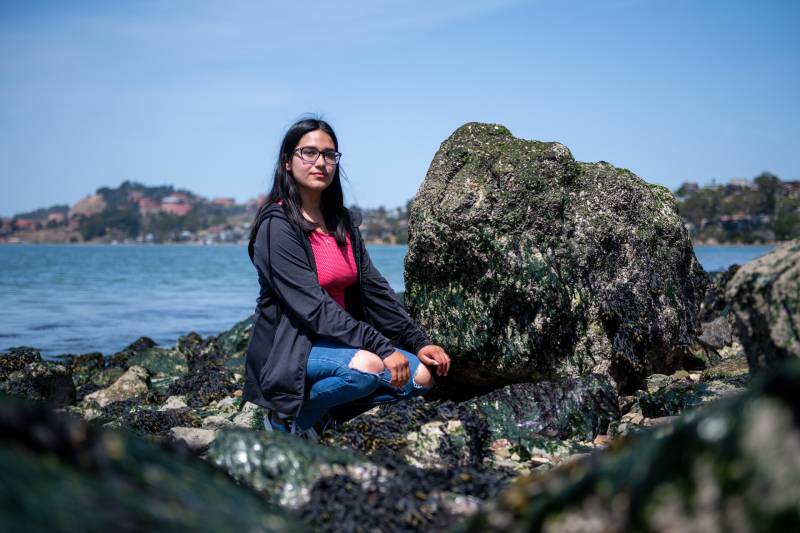 Lizbeth Ibarra, a leader with Youth Vs. Apocalypse, sits near the bay at the Miller/Knox Regional Shoreline park in Richmond on April 7, 2022. (Beth LaBerge/KQED)
Lizbeth Ibarra, a leader with Youth Vs. Apocalypse, sits near the bay at the Miller/Knox Regional Shoreline park in Richmond on April 7, 2022. (Beth LaBerge/KQED)
‘We’re stuck because of a political maneuver’
A marsh and a narrow bike trail separate the toxic site from the bay. It’s clear why developers want to turn this patch of land into shoreline housing. The property, filled with yellow flowers and shades of green shrubbery, is beautiful, with the Berkeley, Oakland and San Francisco skylines in view and the natural allure of the bayfront: Birds, porpoises and crabs fill the water below.
But residents, advocates and scientists are worried about keeping hazardous chemicals out of the natural environment. Those impacts were detailed in a study from 2012, conducted by UC Davis Bodega Marine Laboratory and UC Santa Barbara researchers, which found that chemicals leaking into the marsh at the edge of the site have given fish tumors and altered their sexual anatomy (PDF).
In 2019, the Richmond City Council approved a cleanup plan proposed by the state to remove portions of the contaminated soil and cap the rest with a protective seal above ground. The partial cleanup was not the preferred option of many residents like Blum.
“We’re stuck because of a political maneuver,” he said.
Tom Butt was the city’s mayor until this month. He pushed for the project and said he was “comfortable” with the DTSC and council-approved plan to leave toxics under a residential housing development.
“Housing is our biggest need statewide and region-wide right now, and this would go a long way toward fulfilling that,” he said.
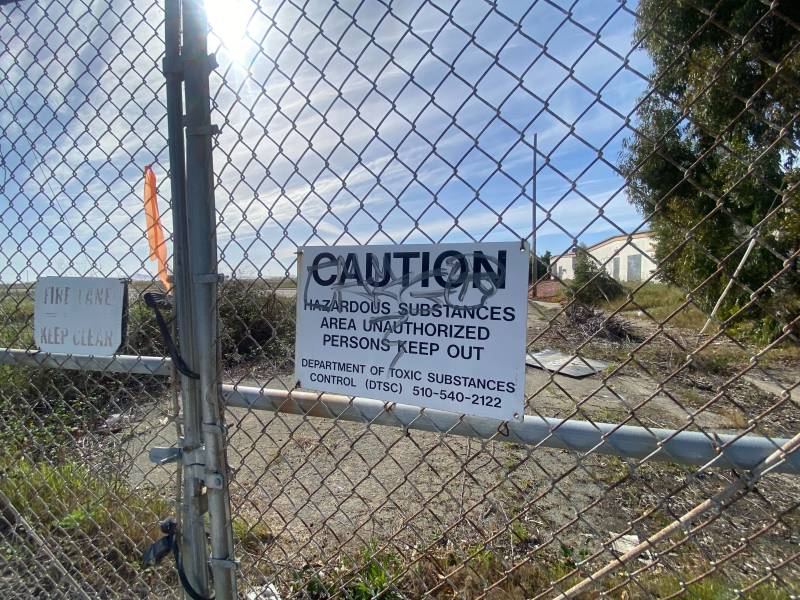 The AstraZeneca site closed in the late ’90s. For more than two decades, advocates have fought to make sure the site is fully cleaned up before it can be ready for development. (Ezra David Romero/KQED)
The AstraZeneca site closed in the late ’90s. For more than two decades, advocates have fought to make sure the site is fully cleaned up before it can be ready for development. (Ezra David Romero/KQED)
‘Groundwater is the conveyor belt for the chemicals’
The company-led sea level rise evaluation (PDF) prepared by consultants found that there will be no negative impacts from rising seas by the year 2050. Still, the developer might have to modify an underground barrier to treat groundwater before it reaches the bay by the end of the century.
UC Berkeley’s Hill and University of Arkansas geosciences professor Kevin Befus, who worked on projects for the U.S. Geological Survey modeling groundwater in the Bay Area, reviewed the evaluation for DTSC.
Hill’s critique of the AstraZeneca study centers on the model the company’s consultants used to examine rising groundwater, which took a profile of the existing water table and raised it as “if it were frozen in shape.”




















